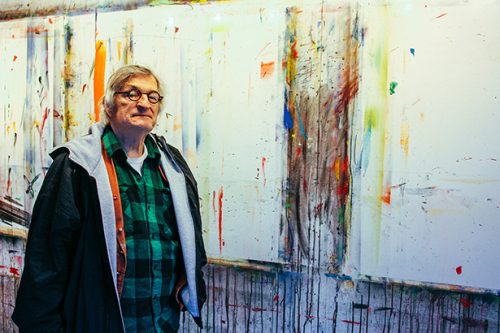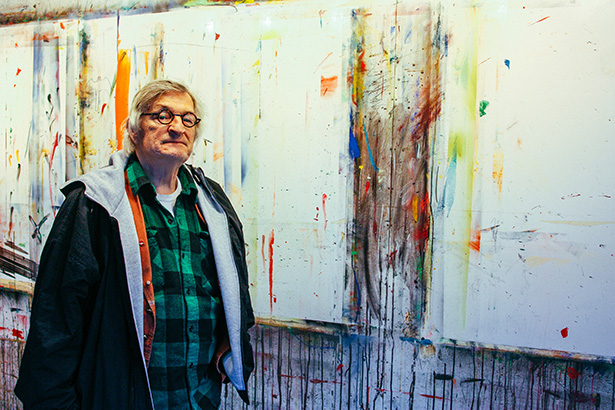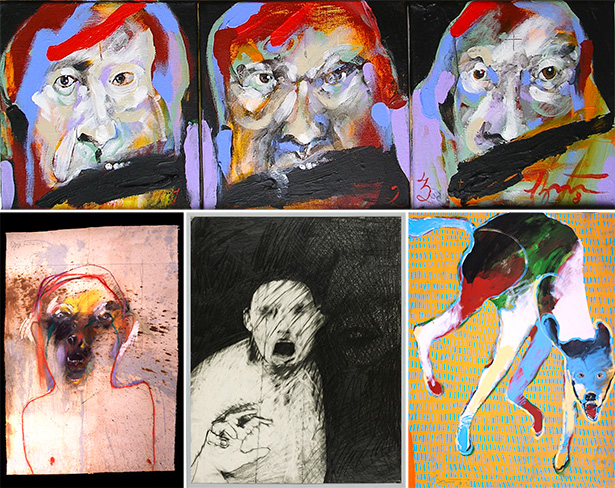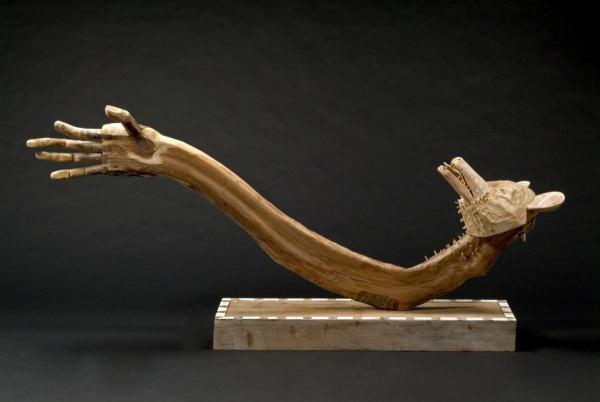
If Rick Bartow reads this — which he won’t, he already told me so — he would probably furrow his brow and mutter something about the article being too “woo-woo,” a term he often uses when talk gets too reverent or lofty, usually in discussions of art or religion.
Many call him a national treasure, but the artist is not precious about himself or his work. Nor does Bartow like to be romanticized, for his Native Wiyot heritage or for struggles with addiction and PTSD, both of which inspired some of his most poignant work, housed in over 50 museums around the world, including two 20-plus feet cedar columns installed at the Smithsonian’s National Museum of the American Indian.
“He could give a rat’s ass about fame or what people think,” says Charles Froelick, his agent and friend of 23 years and owner of the Froelick Gallery in Portland. “He loves making art. He wants nothing more than to be making art. If some are failures, fine.”
For Bartow, the art, or “the work,” is paramount. The rest fades away.
 |
|
‘There’s no reason i should be making a life with these crazy pictures, but I am.’ — Rick Bartow.
Photo by Alex V. Cipolle |
But work can’t keep the inevitable at bay forever. At 68, Bartow has survived two strokes, congenital heart failure and, on the day we met, he was mulling over the fact that he’s going blind in one eye.
And yet Bartow is more productive and focused than ever, Froelick says. After 40 years of making art, Bartow hopes for 10 years more. He’s not quite done, the artist says.
All this gives the upcoming retrospective on Bartow, Things You Know But Cannot Explain, a sense of urgency. Opening at the Jordan Schnitzer Museum of Art April 17, the show will feature more than 120 paintings, drawings, sculptures and prints, including works the artist has completed in recent months. JSMA Director Jill Hartz, who co-curated the exhibit with Danielle Knapp, says there is a new joy and confidence to Bartow’s work, and that the exhibit just scratches the surface.
“The artwork has been fearless,” Froehlick says. “Since his stroke in 2013, he’s been more productive than I’ve ever seen him. Ever.”
Napkin and Pen
Sitting at a little table in Panini, a bakery in his hometown of Newport, Bartow looks like a Kurt Vonnegut doodle with his silver mop of hair peaking out from under a leather cap, his angular nose and dark, round-framed glasses circling dark, smart eyes. He’s calm but peeved as he discusses a gig he has that night with his band, the Backseat Drivers.
“The stroke wiped out all the lyrics of 50 years,” Bartow says, explaining that he must now read lyrics instead of relying on memory. “The spirit of it, everything, was gone.”
After his most recent stroke in August 2013, Bartow lost his speech, and has been working to regain it ever since. “The lips and the mouth were like somebody else’s. It sounds like the Swedish guys in the Muppets,” he says. “I can’t spend the rest of my life sounding like a Muppet.”
Bartow sounds nothing like a Muppet, at least not anymore. His speech is slow but deliberate, elegantly parsed, although he says he still suffers from bouts of paraphasia, or what he calls “yaba yaba,” a scrambling of syllables and words.
He tells me that, while recovering from the stroke in his hospital bed, he snatched a napkin and a pen from a nurse. “I could draw a bird and a hawk,” he says. He then called Froelick and said, “I’m OK. I can draw.” Bartow was up and walking around his studio days later.
The first sounds Bartow could wrap his mind and mouth around, he says, were “A-B-C” and “one-two-three,” a thin thread that tied him to his former vocabulary. From this came one of his first major post-stroke pieces, “ABC 123,” a large pastel and graphite work with those letters and numerals scratched out beneath a glowering bespectacled face.
“I was simply trying to work through it,” Bartow says. “I found it fascinating. A sort of study of my own brain.”
The Work: Making Marks
At a recent artist talk at the Hult Center with Bartow and Froelick, arts writer and moderator Bob Keefer asked Bartow what he does when he hits a dry spell. With a toothpick pressed between his lips, Bartow gave a shrug and said, “I don’t.”
He explained to the crowd that, if you’re an artist and you’re not working on a piece, you should be working on your studio. “Then you’re ready for the spirit to visit you once again.”
I ask Froelick about this. “He’s often said that there’s a fallacy of the theory of the artist waiting for a muse to hit because if you’re not in the studio, if you’re not making marks, making work, then the muse may never come calling,” Froelick says. “You have to be ready.”
Bartow will tell anyone who asks that the only thing that can trump the trials and tribulations of life is work. In fact, he wanted to call the exhibit Work but was overruled because “it was too kitschy or too simple,” he says.
“Work. That’s the only thing. That’s the only way. Work. Work,” Bartow explains. “Do what you can, as long as you can, because I don’t see anything else. My place to have fun is work. To get out of pain — working. There’s not much else outside of that.”
There is mischief and white-hot joy in Bartow’s work. His crows hop and his bears dance; his rough-hewn wooden sculptures tilt and wink.
His cerulean blues, blackened indigos, mustard yellows, fleshy pinks, blood oranges and reds bounce around the canvas, recalling the palettes of Miró or Chagall.
“He’s an incredible colorist,” Hartz of the JSMA says. “How he mixes his colors on the canvas — this confidence of how to put color on the canvas — not a lot of artists have that,” adding, “and the humor that he has with it.”
But, she warns, the artist is a trickster. “You don’t want to get stuck in this idea that, because he’s so influenced by Native American culture, could this mean something? Is the raven ‘X’?” she says. “It could be anything. He’s created the work and now the rest is up to you. Whatever it has for him is for him.”
 |
| Clockwise from top: ‘PTSD I,II, III’ (2008), ‘Dog Running’ (2012), ‘Things You Know But Cannot Explain’ (1979), ‘Bear Coming’ (1999) |
The Work: Teeth
A searing pain also defines Bartow’s art, like a beating, aching heart smashed on a canvas. It evokes the kind of raw emotion rarely seen these days in the cool, conceptual halls of contemporary art.
In this way, Bartow reminds one of the late 20th-century English painter Francis Bacon. Coming face to face with Bacon’s twisted, pulpy masses writhing in agony was the first time a painting scared me, and I liked it. I liked that a painting could still do that. The second time I got those chills was looking at some of Bartow’s darker works.
Those same playful bears and crows — as well as coyotes, ravens, dogs and deer — can turn sinister fast, mutating in and out of human forms, both skeletal and in the flesh.
Take “Bear Coming,” an explosive, 6-foot-high mixed media on paper piece Bartow made in 1999. From the ragged red outlines of a nude figure emerges a snarling bear, his pupils and teeth glistening with menace.
“The bear is of interest as both awesome and scary. It teaches us life ways through humor, through taking care of children, of finding ways to heal,” the JSMA exhibit catalogue quotes Bartow.
“He often talks about the honesty of his work,” Hartz notes. “It’s not worth it if it’s not absolutely honest and true with his being.”
Bartow tells me shortly after we meet about an encounter at one of his shows. “A woman one time fell sobbing into my arms … and said I painted her life,” he says. “All I could do was say ‘I’m sorry.’” Weeks later, I ask him about this. Why was he sorry?
“If you look at a lot of the drawings I make, things are pretty skewed. A lot of them are not real happy looking.” If she was responding to the colors, that would be one thing. “But if she has one of the pictures of the spirits deviling some the characters in the pictures,” he says, “then there’s a lot of things going on. I think she was feeling some sort of akin to that, but still, it’s rough ground.”
In studying Bartow’s work, it’s the teeth that unnerve me. They chatter and cackle and taunt the viewer; teeth gnashing everywhere.
“Because they were all falling out of my head — alcohol,” he explains, while touching the grooves of a dry etching he’s working on in his studio. “I wasn’t taking care of them so they were falling, quite literally, out of my mouth.”
Teeth appear again in 2008’s “PTSD I, II, III,” an acrylic triptych of a man gnawing on a dark object.
“I danced around death with PTSD and alcohol and dope and cigarettes,” Bartow says.
This imagery is rooted in a string of traumatic experiences, and the road back to peace. After studying art at Western Oregon University in the ’60s, Bartow entered military service in Vietnam — a period, he says, that left him like a “scrambled egg.”
“I did work, but most everything I did was centered around being an alcoholic — being drunk so I didn’t have to feel, I guess. And that’s kind of romantic, because I was just a drunk,” he says.
Bartow’s father passed away when Bartow was 5. His father was in World War II and also struggled with alcohol; Bartow often wonders if his father also had PTSD.
“He was a sweet guy, but he had the devil in him,” he says. “And I know all about it.”
When his addiction comes up, Bartow, who has been clean and sober for 32 years, frequently mentions the Red Road, “the native spiritual way of working on yourself,” as well as his late buddy, Walter Klamath. Klamath worked in the sweathouse of the Siletz tribe outside Newport helping people get clean. Bartow now does the same.
“Hanging out with him rubbed off,” Bartow says. “After a certain point I stopped going to AA regularly and started going to the sweathouse.”
He adds, “We used to say if it didn’t hurt we didn’t remember it.”
The Work: Bones
Bartow is shuffling around his sculpture studio, a rustic woodshop on a friend’s property. He picks up tool after tool, customized hammers and blades, and holds them to the light streaming through the windows like a proud collector. He mentions this is where he made the wooden sculptures — “Facing The Future Eyes Wide Open” and “Coming and Going Fish” — for the UO Ford Alumni Center.
From here, we move on from teeth to bones, which appear just as frequently in his work.
There’s an oft-told story about Bartow. In 1996, the artist traveled to New Zealand to exhibit his work and visit friend and mentor John Bevan Ford, a Maori artist. Lawrence Fong, a former JSMA curator and friend of Bartow’s, writes in the exhibit catalog:
“After he arrived, he was presented with a box containing five American Indian skulls that had been in collections storage. ‘It was like being shown the head of my grandmother,’ he said. Bartow consulted elders in the U.S. about his role and how to properly receive the sacred remains.”
Bartow transported the skulls back to the U.S.
“It took a little while to get over that,” he says. The memory rears its head in several of his paintings, most notably the 1996 piece “Nak May Kway Let Way (My Crying Eyes for You)” and 2010’s “The Returning.”
Bones also rattle the personal heritage of Bartow, who didn’t find out he was Wiyot until age 55. He walks over to a worktable covered with roughly molded clay faces and picks one up. “For the massacre of the Wiyot people,” he says.
In 1860, a group of white men slaughtered the northern Californian tribe while they were hosting a ceremony on what was then called Indian Island. Bartow attended a memorial ceremony on the island in 2014.
“There are still human bones laying on the ground because they just threw the people in there and left them. Though they’ve tried to clean everything up, there’s still places where you’ll find it here and there. Very sad,” he says, shaking his head.
For generations, he and his family wondered about their heritage, knowing they were of native descent but guessing they were Yurok because of ties to California’s Mad River area.
“We all kind of walked around wondering,” Bartow says. “And suddenly, a marvelous day, and they come and say, ‘You are a part of our nation.’ Then they took us out and show us our river, show us our land. Show us what we’re looking at belongs to us.”
He shakes his ahead again. “Oh man, I think of uncles and aunts that died wondering what’s going on.”
Bartow is quiet for a moment before continuing. “The first one to know who she was was my 12-year-old daughter [Lily],” he says. “She was the first one who had the whole story.”

The Spirit
The sidewalks of the Historic Nye Beach district are wet and empty. It’s a sleepy, blustery March afternoon in Newport, a town where Bartow’s grandparents settled nearly a century ago, where his father passed away, where his son Booker was born and where his late wife demanded he “quit farting around” and become an artist.
While sipping coffee, Bartow looks out the bakery’s misty windows and up the hill to Café Mundo, where his band will play later. He wonders if anyone will come out for the show that night. Probably not. It’s the slow season, he says.
I ask him about the title of the exhibit, Things You Know But Cannot Explain, named after an early work of his — a haunting 1979 study of graphite on paper.
“I didn’t choose that one,” Bartow says, adding that he had all but forgotten about it. With some prodding he remembers that, at the time, a buddy moved in to help him quit drinking and gave him a box of graphite sticks. With these, he created the image of a scratched-out man, mouth agape and right hand curled in a defensive claw. In the crosshatched blackness behind the figure, a large, nearly invisible face looms.
“I didn’t know if anyone was going to see the big face,” he says, pointing down at the print I’d spread out on the table. “The spirit is there.”
It seems the spirit is always looking over Bartow’s shoulder. Sometimes he refers to it as “great spirit, or “muse” or “God,” but it’s a theme that comes up repeatedly in his life and art.
“As artists, I think we’re all blind faith-adhered,” he says. “Anybody who’s working after something, or very involved in it, they would lay down their life for that belief, but they can’t taste it and they can’t see it.”
From the bakery, Bartow drives us across the Yaquina Bay Bridge to his childhood home — a collection of rickety, shingled buildings and a trailer — nestled in a marshy grove. We drive past wooded neighborhoods and marshes and he points to a grassy plot of land where his grandparents first settled. He gestures when we pass a cemetery. “Most of my family lives here,” he says.
The home, where he grew up and once lived with his first wife and son, now belongs to his brother. On the property, there’s a tiny print shop and a small studio where Bartow still works sometimes. The studio is damp and dark save for some spotlights he’s flicked on, shining on a wall taped up with paper streaked by dry pastels and dried paint; below, a mound of colorful pastel dust has piled up inches high.
We walk outside and he nods towards the main house. “My dear wife, this was her last little place to get sanctuary,” he says. “I wander around there every now and then and miss my wife sometimes.”
Bartow’s wife Julie passed away from breast cancer at 50.
We climb back into his SUV. “Heartaches and heartaches,” he says as we pull away. “We are as much of what we lose as what we gain.”
As we drive off, I realize it’s lucky that the piece the exhibit is named after exists at all.
“I’d get drunk and had a burning barrel out down the house and, in middle of the night or whenever I wrangled myself enough to stand up, I burned everything.” He pauses a moment.
“There were several bonfires of vanity,” he continues, with a wry laugh. “I’m sure it couldn’t have been that tragic. A few pieces left kind of showed me that was a pretty good way of editing, but it also goes back to: I’m not real hoity-toity with my work.”
Firestarter
Hartz says Bartow’s health was a primary reason she and co-curator Danielle Knapp tackled this retrospective now. “It shook everybody else up, if not him,” she says.
Froelick agrees. “There are milestones that nobody wants and maybe they’re firestarters and reminders that if you’ve got something, you better put it out there or you’re wasting it,” he says. “He’s enjoyed the joy of birth and the innocence of a flowers, the gruesome realities of genocide and the mournful losses of death, and he is willing to approach and address all aspects of life with equal energy and importance. That is his legacy. He’s not one-sided. He doesn’t just make sunflower paintings.”
Rick Bartow: Things You Know But Cannot Explain runs April 18 through Aug. 9 in the Barker Gallery of the Jordan Schnitzer Museum of Art. An opening ceremony honoring Bartow hosted by UO assistant vice president Jason Younker with remarks from Charles Froelick, Jill Hartz, Newport mayor Sandra Roumagoux and UO interim president Scott Coltrane starts at 5:30 pm Friday, April 17, at the UO Memorial Quad. Artist Frank LaPena will give a prayer and singers from the Confederated Tribes of Siletz Indians will perform. Following the ceremony, the museum will host an opening reception featuring live music by Rick Bartow and The Backseat Drivers 6 to 8 pm; free. For the full program of events, visit wkly.ws/1zr.